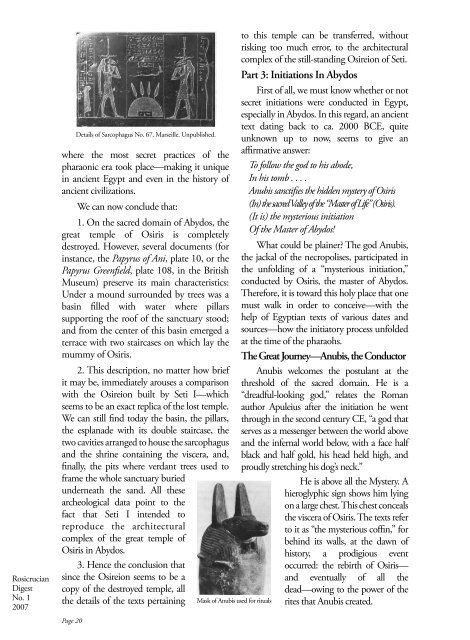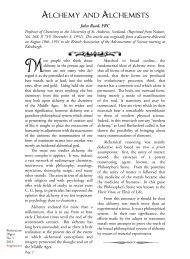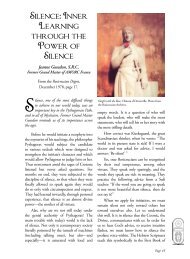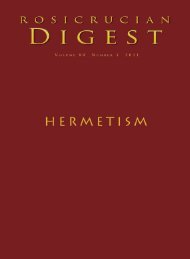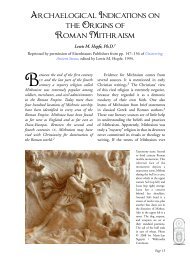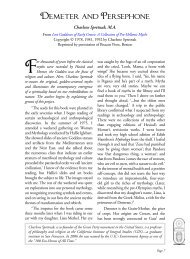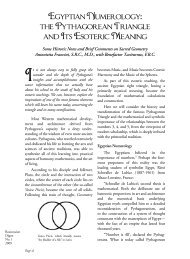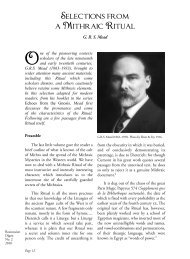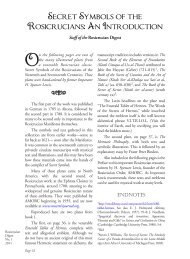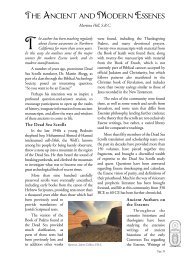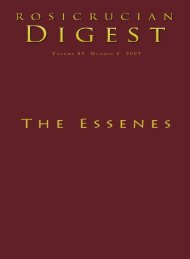Digest - Rosicrucian Order
Digest - Rosicrucian Order
Digest - Rosicrucian Order
You also want an ePaper? Increase the reach of your titles
YUMPU automatically turns print PDFs into web optimized ePapers that Google loves.
<strong>Rosicrucian</strong><br />
<strong>Digest</strong><br />
No. 1<br />
2007<br />
where the most secret practices of the<br />
pharaonic era took place—making it unique<br />
in ancient Egypt and even in the history of<br />
ancient civilizations.<br />
Page 20<br />
Details of Sarcophagus No. 67, Marseille. Unpublished.<br />
We can now conclude that:<br />
1. On the sacred domain of Abydos, the<br />
great temple of Osiris is completely<br />
destroyed. However, several documents (for<br />
instance, the Papyrus of Ani, plate 10, or the<br />
Papyrus Greenfield, plate 108, in the British<br />
Museum) preserve its main characteristics:<br />
Under a mound surrounded by trees was a<br />
basin filled with water where pillars<br />
supporting the roof of the sanctuary stood;<br />
and from the center of this basin emerged a<br />
terrace with two staircases on which lay the<br />
mummy of Osiris.<br />
2. This description, no matter how brief<br />
it may be, immediately arouses a comparison<br />
with the Osireion built by Seti I—which<br />
seems to be an exact replica of the lost temple.<br />
We can still find today the basin, the pillars,<br />
the esplanade with its double staircase, the<br />
two cavities arranged to house the sarcophagus<br />
and the shrine containing the viscera, and,<br />
finally, the pits where verdant trees used to<br />
frame the whole sanctuary buried<br />
underneath the sand. All these<br />
archeological data point to the<br />
fact that Seti I intended to<br />
reproduce the architectural<br />
complex of the great temple of<br />
Osiris in Abydos.<br />
3. Hence the conclusion that<br />
since the Osireion seems to be a<br />
copy of the destroyed temple, all<br />
the details of the texts pertaining<br />
Mask of Anubis used for rituals<br />
to this temple can be transferred, without<br />
risking too much error, to the architectural<br />
complex of the still-standing Osireion of Seti.<br />
Part 3: Initiations In Abydos<br />
First of all, we must know whether or not<br />
secret initiations were conducted in Egypt,<br />
especially in Abydos. In this regard, an ancient<br />
text dating back to ca. 2000 BCE, quite<br />
unknown up to now, seems to give an<br />
affirmative answer:<br />
To follow the god to his abode,<br />
In his tomb . . . .<br />
Anubis sanctifies the hidden mystery of Osiris<br />
(In) the sacred Valley of the “Master of Life” (Osiris).<br />
(It is) the mysterious initiation<br />
Of the Master of Abydos!<br />
What could be plainer? The god Anubis,<br />
the jackal of the necropolises, participated in<br />
the unfolding of a “mysterious initiation,”<br />
conducted by Osiris, the master of Abydos.<br />
Therefore, it is toward this holy place that one<br />
must walk in order to conceive—with the<br />
help of Egyptian texts of various dates and<br />
sources—how the initiatory process unfolded<br />
at the time of the pharaohs.<br />
The Great Journey—Anubis, the Conductor<br />
Anubis welcomes the postulant at the<br />
threshold of the sacred domain. He is a<br />
“dreadful-looking god,” relates the Roman<br />
author Apuleius after the initiation he went<br />
through in the second century CE, “a god that<br />
serves as a messenger between the world above<br />
and the infernal world below, with a face half<br />
black and half gold, his head held high, and<br />
proudly stretching his dog’s neck.”<br />
He is above all the Mystery. A<br />
hieroglyphic sign shows him lying<br />
on a large chest. This chest conceals<br />
the viscera of Osiris. The texts refer<br />
to it as “the mysterious coffin,” for<br />
behind its walls, at the dawn of<br />
history, a prodigious event<br />
occurred: the rebirth of Osiris—<br />
and eventually of all the<br />
dead—owing to the power of the<br />
rites that Anubis created.


